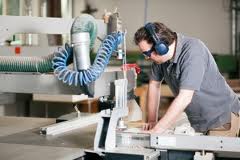The effects of occupational noise on sound perception of engine grinders and airport staff in Northern Nigeria
Keywords:
Noise;Audiometric test;Airport staff;Engine grinders;Hearing thresholdAbstract
Hearing or auditionis the ability to perceive sound by detecting vibrations through the ear. Noiseis perhaps, the most common occupational and environmental hazard. Grindingmachines and airplanes can generate considerable noise (above 85dB) and thus,may cause hearing loss. This research was conducted using an instrument knownas an audiometer to investigate the effect of noise generated from thesesources on individuals that are exposed to it for a long duration. One hundredand fifty (150) subjects divided into three groups of A, B and C, were used forthis study, each group comprising of 50 subjects. Group A (control group),comprised of secondary school staff, while local engine grinders and staff ofAirport Operations Department made up groups B and C (study groups),respectively. Results obtained from the study showed that individuals in thestudy groups had a significantly increased hearing threshold from 28.22±1.26and 28.80±1.29 to 50.08± 1.14 and 50.56±1.21 for the engine grinders,44.92±1.31 and 44.59±1.38 above the normal (0-25dB) in both ears when comparedto the control group. This revealed that the study groups had a poor hearingperception as well as a greater hearing loss than the control group. Inconclusion, since engine grinders and staff of airport operation department aresusceptible to this adverse effect due to their daily exposure to excessivesound (noise), it is advisable that they always work with ear protectivedevices.References
Abdel-Aziz, B.F., Mansour, T.A., Marakby, F.A., 2007. Benefit-Cost Analysis of an Audiometric Screening Program for Workers in a Textile Factory in Alexandria, Egypt, Bulletin Alexandria. Fac. Med., vol.43, no.2, pp. 372-374.
Abdel-Aziz, M.M., Magaji, R.A., Salisu, I.A., 2006. Audiometric Test on Airport Workers in Kano. Niger. J. Neurosc., vol. 6, no.1, pp.1-2.
Bisong, S.A., Umana, A.N., Onoyom-ita, V., Osim, E.E., 2004. Hearing Acuity Loss of Operators of Food Grinding Machines in Calabar, Nigeria, Niger. J. Physiol. Sci., vol.19 no.1-2, pp. 20-27, 2004.
Ekekwe, O., Owolawi, O.W., 2012. Noise- Induced Hearing Loss among Nigeria Printing Industrial Workers. Online J. Med. Med. Sci. Res., vol.1, no.2, pp. 32-36.
Enrique, A.L., Alan, R.P., Ray, M., 2010. The Neurophysiological basis of Auditory Perception. NewYork Springer., Pp. 99-110.
Ighoroje, A.D.A., Marchie, C., Nwobodo, E.D., 2004. Noise-Induced Hearing Impairment as an Occupational Risk Factor Among Nigerian Traders. Niger. J. Physiol. Sci., vol. 19, no. 1-2, pp. 14-19.
Jan, S., Israel, N., Andrew, K., 2011. Making Sense out of Sound, Auditory Neurosience. The MIT Press, Cambridge, Massachusetts London, England.
National Institute for Occupational Safety and Health., 1998. Criteria for A Recommended Standard: Occupational Noise Exposure, Revised criteria 1998. U.S. Dept. of Health and Human Services Public Health Services. Center for Disease Control and Prevention. National Institute for Occupational Safety and Health. Cincinnati, Ohio.
Peter, M.R., 2000. Noise-induced Hearing Loss. Amer. Family Physician., vol. 61, pp. 2749-2756.
Smith, A., 2004. The fifteenth most serious health problem in the WHO perspective, Presentation to IFHOH World Congress, Helsinki, July 2004. Available at http://www.kuulonhuoltoliitto.fi/tiedoston_katsominen.php?dok_ id =150.
Work Safe Victoria., 2005. Guide For Assessing and Fixing Noise Problems At Work,” Available at: www.worksafe.vic.gov.au.retrieved on., 12/5/2013, 2005.
World Health Organization., Guidelines for community noise, Edited by Berglund, B., Lindvall, T., Schwela D.H., 1999. Available at http://www.who.int/docstore/peh/noise/guidelines2.html.
World Health Organization., 2001. Occupational and community noise, Fact sheet Number 258. Revised February, 2001.Geneva.

Published
How to Cite
Issue
Section
Copyright (c) 2014 J. A. Tende, A. Mohammed, E. D. Eze, Y. A. Tende, O. A. Daikwo, O. Onaadepo, I. S. Malgwi, A. Shaibu

This work is licensed under a Creative Commons Attribution-NonCommercial-NoDerivatives 4.0 International License.



